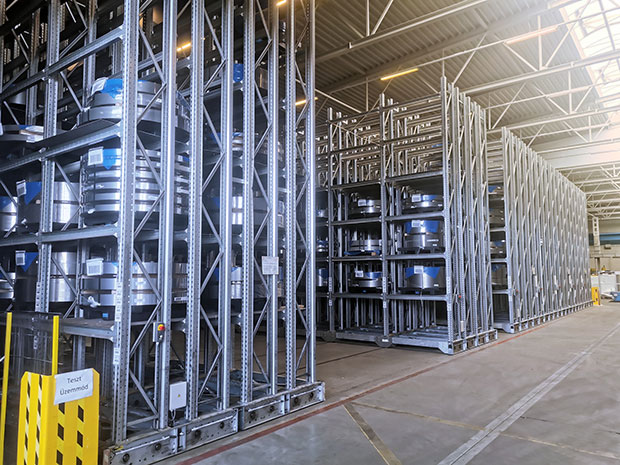A 17-year-old mobile racking system from thyssenkrupp Materials Hungary was brought back to the current state of the art through retrofitting. As part of a comprehensive modernisation, OHRA replaced damaged mechanical parts of the traversing carriages and modernised the entire electrical engineering. The retrofitting ensures that the plant will continue to operate with a high level of availability in the future, so that thyssenkrupp Materials can continue to supply its customers with goods reliably and on time.
 In Hungary, thyssenkrupp Materials Hungary is one of the leading trading companies for steel, light metal, non-ferrous metal, and plastic materials. To have direct access to a large number of different sheet metal coils with high storage capacity, the company installed pallet racks mounted on traversing carriages in 2005. But after 17 years in service, the supply of spare parts is proving increasingly difficult. Many components of the control and switchgear system of the mobile racking were discontinued or no longer available. However, as the steel structure still met all requirements, thyssenkrupp Materials Hungary decided to retrofit the racking system. As OHRA had already planned and installed a mobile cantilever racking system at the company, the specialist for heavy-duty storage technology was also commissioned to modernise the coil mobile racking system – even though this was installed by a third-party supplier at the time.
In Hungary, thyssenkrupp Materials Hungary is one of the leading trading companies for steel, light metal, non-ferrous metal, and plastic materials. To have direct access to a large number of different sheet metal coils with high storage capacity, the company installed pallet racks mounted on traversing carriages in 2005. But after 17 years in service, the supply of spare parts is proving increasingly difficult. Many components of the control and switchgear system of the mobile racking were discontinued or no longer available. However, as the steel structure still met all requirements, thyssenkrupp Materials Hungary decided to retrofit the racking system. As OHRA had already planned and installed a mobile cantilever racking system at the company, the specialist for heavy-duty storage technology was also commissioned to modernise the coil mobile racking system – even though this was installed by a third-party supplier at the time.
Firstly, OHRA replaced all wheels and wheel bearings – a total of 560 each – of the transfer trolleys. Then the control cabinets of the plant were completely replaced as both spare parts and service were no longer available. Today, all functions and diagnostics are controlled via an intuitive colour touch screen. A soft-start function now ensures gentle starting and braking of the transfer carriages – this reduces wear and protects the stored goods. To continue to meet safety requirements, the safety system was also updated. Among other things, the entire racking block as well as each transfer trolley was equipped with self-checking optical sensors at the front and rear.




Comments are closed.